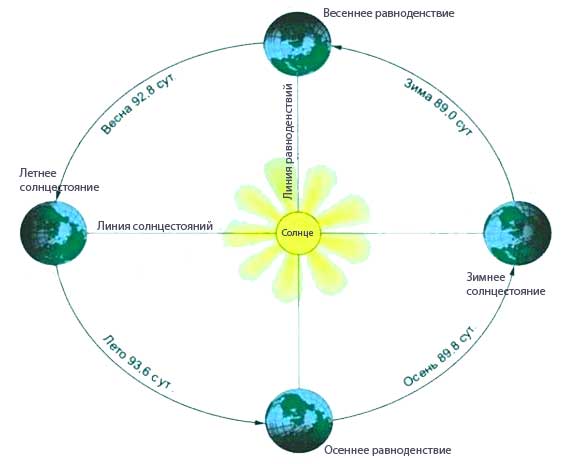How to explain to children why winter is coming? Seasons on the planets of the solar system
So the earth has two different motions. First, it rotates around its axis once a day. Secondly, it goes around the Sun in one year. As a result of the first movement of the Earth, there is a change of day and night; as a result of the second, as you will now see, there is a change of seasons.
If the Earth moved around the Sun in such a way that its axis of rotation was always at right angles to the sun's rays, there would be no change of seasons on Earth. Look at fig. 4. Wherever the Sun illuminates the Earth - to the right, to the left, in front or behind, as long as its rays fall on earth's surface at right angles to earth's axis, would make no difference. In all cases, the rays of the sun would fall vertically at the earth's equator and would slide along the earth's surface at the poles. Anywhere on Earth (except the poles), due to its rotation around its axis, the night would last 12 hours and the day would last the same amount. The sun would always rise in the east and set in the west, making the same path through the sky from day to day. There would be no change of seasons on Earth.
In reality, however, this is not the case.
It turns out that the rays of the Sun only twice a year - on March 21 and September 23 - fall on the Earth at a right angle to its axis of rotation. This means that only twice a year - in spring and autumn - does it happen that day and night last 12 hours, but the rest of the year either the night is longer than the day, or the day is longer than the night.
Rice. 8. The tilt of the earth's axis to the rays of the Sun at the end of June
Look at fig. 8. It depicts the Earth, on which the sun's rays fall from the right. Therefore, it is day on the right half of the Earth, and night on the left. Now pay attention to how the axis of rotation of the Earth is located. It is inclined towards the rays of the Sun and at the same time so that its northern part (in the figure - upper) is inclined towards the Sun, and the southern (in the figure - lower) is inclined away from the Sun. As a result, the northern part of the Earth receives much more heat and light than the southern part.
Look now at the north pole of the earth. Not only he himself, but also a significant part of the earth's surface around him is illuminated by the sun's rays. No matter how much the Earth spins, neither at the northernmost pole, nor around it, with such a position of the earth's axis, night cannot come: there will be day around the clock.
In areas more distant from the north pole, the change of day and night will already occur, but, as it is easy to figure out, the day will be longer than the night. And only at the earth's equator, that is, just in the middle between the two poles of the Earth, the duration of day and night will be the same.
Quite different will happen in the southern hemisphere. Both the south pole of the Earth itself and a significant part of the earth's surface around it are not illuminated by the sun's rays. This means that at the South Pole and near it, night will last around the clock. In areas more distant from the South Pole, night will already be replaced by day, but its duration up to the equator will be longer than the duration of the day.
From all that has been said, it is now easy to understand that with such an inclination of the earth's axis, as in Fig. 8, it will be summer in the northern hemisphere of the Earth, and winter in the southern hemisphere (the winter months in the southern hemisphere are June - August).
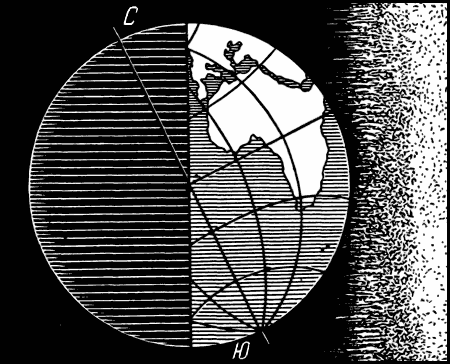
Rice. 9. The tilt of the earth's axis to the rays of the Sun at the end of December
Look now at fig. 9. It also depicts the Earth, illuminated to the right by the sun's rays. However, the Earth's axis of rotation this time is tilted in the opposite direction: its northern end is away from the Sun, and its southern end is towards the Sun. The North Pole with the part of the earth's surface surrounding it is immersed in darkness. On it and around it, the night lasts around the clock. A little further from it, the change of day and night occurs, but everywhere the day is shorter than the night. It will be winter in the northern hemisphere of the Earth. In the southern hemisphere of the Earth at this time, obviously, summer. There, the day is either longer than the night, or (at the South Pole and near it) lasts around the clock.
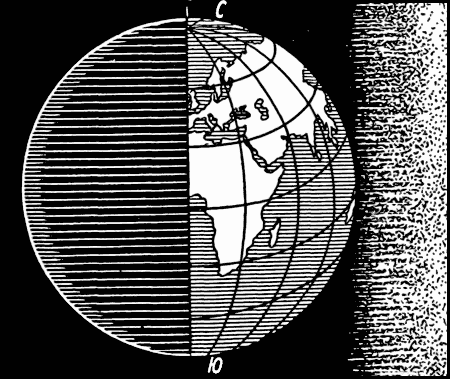
Rice. 10. The inclination of the earth's axis to the rays of the Sun at the end of March and at the end of September
About how the axis of rotation of the Earth is located relative to the rays of the Sun in spring and autumn, it has already been said: the sun's rays fall on the Earth at right angles to the earth's axis. In this position, the Earth is shown in Fig. ten.
Of course, we must remember that at the time when it is autumn in the northern hemisphere of the Earth, it is spring in the southern hemisphere, and vice versa.
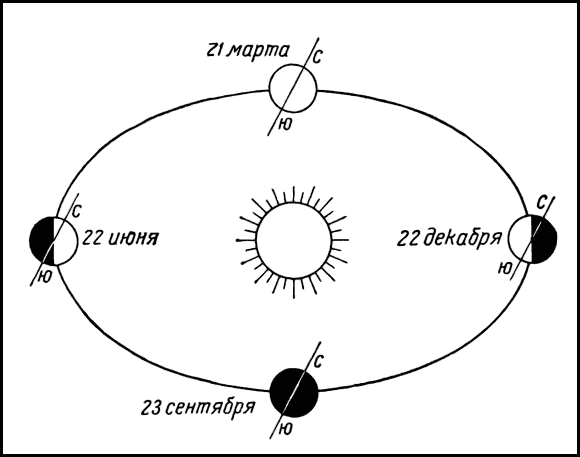
Rus. 11. Change in the inclination of the earth's axis to the rays of the Sun during the year
Now look at fig. 11. It gives a general picture of the change in the position of the earth's axis relative to the Sun during the year.
The Sun is in the middle of the picture. The path of the Earth is depicted somewhat from the side, so it is not round, but elongated. The earth is shown on it in four positions: March 21, June 22, September 23 and December 22. The figure clearly shows that at different times of the year, the axis of rotation of the Earth retains the same position, inclined to the path along which the Earth moves around the Sun. That is why in different parts of the year the Sun illuminates more strongly either the northern or the southern hemisphere of the Earth, that is, that is why the seasons change.
Indeed, at the position of the Earth on March 21 and September 23, the northern and southern hemispheres of the Earth (as in Fig. 10) are located in the same way relative to the sun's rays.
On the whole Earth at this time, day and night last for 12 hours. March 21 in the northern hemisphere - spring, in the southern - autumn; September 23, on the contrary, - in the northern hemisphere - autumn, in the southern - spring (in Fig. 11 on March 21, half of the Earth illuminated by the Sun is visible, and on September 23 - unlit).
The position of the Earth on June 22 is the same as in Fig. eight. North hemisphere The Earth receives more heat and light from the Sun than the south. In the northern hemisphere it is summer, in the southern hemisphere it is winter. Finally, the position of the Earth on December 22 corresponds to Fig. 9. In this position, the northern hemisphere of the Earth receives less heat and light than the southern. In the northern hemisphere it is winter, in the southern hemisphere it is summer.
So, it turns out that the change of seasons occurs on Earth because the Earth's axis of rotation is tilted to the path along which the Earth moves around the Sun. If there were no inclination of the earth's axis, if it were located at a right angle to the path of the Earth around the Sun, in any place on Earth the daily path of the Sun above the horizon would remain unchanged throughout the year. And then there would be no spring, no summer, no autumn, no winter. Throughout the year, the weather in certain places on Earth would be approximately the same: it is coldest at the earth's poles, everything is hotter at the equator. But there would be no change of seasons.
Tell me, how did you spend your last weekend? Sunbathing, playing snowballs or splashing in autumn puddles? What do you wear to the street? Each of our days depends on the time of year. in winter- skiing, summer- bathing, autumn- a trip for mushrooms, and spring we take off our warm clothes and rejoice in the gentle Sun. I will try to explain why there is a change of seasons.
Year on Earth divided by four seasons. Winter- long evenings and short days, summer- the favorite time of most people, the days are the longest of the year, and the sun is high in the sky. There are also so-called off-season - autumn and spring. During these intervals, change from winter to summer and vice versa. Each season brings its own rules to nature:
- winter- the time when nature "falls asleep";
- Spring- a period of awakening and rapid growth;
- summer- the time when most species of flora and fauna enter the breeding phase;
- autumn- gradual withering, slowing down of natural mechanisms.
Why does the seasons change
To understand the principle change of times need to imagine our planet, and let the imagination draw Earth's trajectory in the open outer space. Earth makes two movements: during the day around its axis, and around our star - sun. The revolution around the star is 1 year, a the trajectory is elliptical.
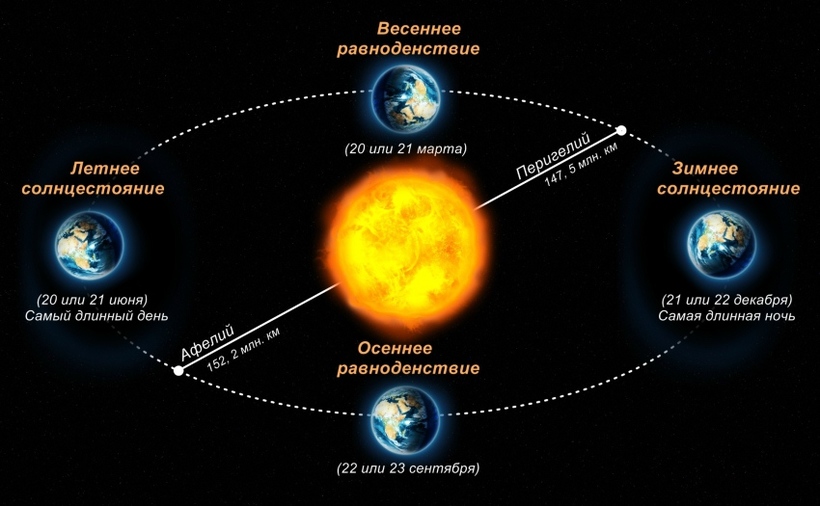
You can often hear the misconception that the change times occurs due to such a peculiar orbit, but this is not true. The main role is played by the angle of inclination of the axis equal to 23.5 degrees. Hemisphere closest to sun, Southern or Northern, will receive almost 3 times more thermal energy, and, therefore, there will be green summer. On the opposite will reign winter, in all its white splendor. Thus, if we imagine the absence of an angle of inclination of the axis, then seasons would not exist in principle, and warming up air masses would happen equally.
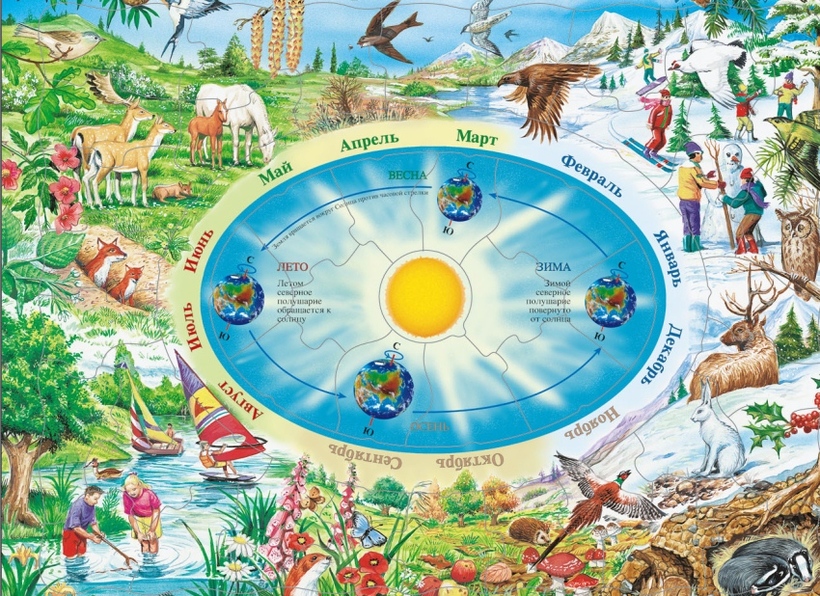
What would be...
An interesting question: what would happen if our planet had a different angle of inclination of the axis, or do not have it at all? Turning on your imagination, you can consider three cases:
- the angle of inclination is 0 degrees;
- angle is 45 degrees;
- the angle is 90 degrees, Earth on its side.
The tilt angle is 0 degrees. If so, we would live in the conditions of eternal spring or autumn, the days would be equal to the nights, and similar to each other like twins. At the poles, there would be eternal morning, and the climate would be much milder.
The angle is 45 degrees. In this case, the temperate zone would not exist, and the cold zone would adjoin the hot zone. AT Moscow throughout June there would have been continuous day, and in the winter months there would have been continuous night. At the poles, a relatively warm summer would be replaced by a harsh winter, and the Arctic ice masses would noticeably decrease in volume.

The earth is on its side. At the poles, day would reign for half a year, and when changing to night, twilight would last for several days. In mid-latitudes, the days would increase with the beginning of spring, and then a day would come that lasted several days. For latitude Peter, for example, such day could be equal to 130 days. In winter, on the contrary, there is a many-day dark night. At the equator, day would be equal to night.
How boring it would be to live if the frosty winter had not been replaced by a young and tender spring, it would not have been replaced by summer with holidays and fresh fruits and vegetables, and velvet autumn is generally loved by many people for its calmness and beauty. We accept all the seasons, rejoice in them, and rarely think about why the seasons change. This turns out to be difficult. a natural phenomenon based on the position of the planets - the Sun and the Earth.
Annual circle of the Earth
If we talk about the change of day and night, then it is much easier to understand here. The Earth turned to the Sun as your city, you have a day, turned away, you look into the dark space - you have a night. The Earth rotates around its axis in 24 hours. The reason for the change of seasons is that, in addition to this rotation, the Earth makes a circular path around the Sun. She goes through this circle in 365 days and 6 hours, this time period is called a year. For 4 years, it accumulates 4 times for 6 hours, and a leap year appears in the calendar, in which 366 days.
How the seasons change
The thing is that the Earth is not directly in the Sun's orbit, but at an angle, the Earth's axis and the Sun's orbit form an angle of 23 degrees 27 minutes. And it turns out that one hemisphere is always closer to the Sun, and the second is farther. So one is summer and the other is winter. It should be noted that in order for summer to come, it is necessary that the rays of the Sun hit the Earth at a right angle. When the Earth turns to the Sun at a tangential tilt, it turns out that the distance to the southern and northern hemispheres is the same, then spring and autumn come. There are two days in a year when day equals night, and in the northern and southern hemispheres these parts of the day are compared. This happens around September 23rd and March 21st. It is always summer at the equator, because the distance to the sun does not change here, the rays are always direct, and they provide heat. There are places where it is always winter for the same reason. The sun's rays very rarely hit the Earth's poles at right angles, only tangentially. And, as we know, gliding rays cannot melt the ice, they only illuminate the Earth. Only one thing always remains stable - the tilt of the Earth's axis, it is always directed to the North Star, which always points to the north.
Earth and Sun Model
To better understand how the seasons change, you can independently make a model of the Earth and the Sun. Take a table lamp and place it in the center of the table. Now take the old ball, pierce it with a regular knitting needle exactly in the center. So we clearly marked the axis of the Earth. Tilt the axle about 23-25 degrees, do not jerk your hand or change the direction of the axle. More illuminated half of the ball on top? So it's summer there. Now rotate the ball, move it 90 degrees. Half, previously bright, became illuminated on a par with the second half. Therefore, autumn has come here. Now move another 90 degrees, our half of the ball has become darkened. It is winter here now, the rays of the lamp fall on it only in passing. After the next 90 degrees, our half will be illuminated a little brighter, and, returning to its previous position, it will again become the brightest. It's been a whole year!
The root cause of everything
This is how the world around us works, the change of seasons is a brilliant idea of nature, the Universe. It is she who ensures balance in space, makes not only the seasons change, but also water circulates on the planet, volcanoes erupt, currents move in the ocean. Everything on Earth happens precisely because of this, namely, the forces that ensure the interaction between the planets, and in our case between the Earth and the Sun.
In the article, we will understand. Using simple examples, we will show why the seasons change, why it is cold in winter and warm in summer. Many people know from school course that the earth rotates on its axis and around the sun. Moreover, the earth rotates around the sun along a trajectory resembling an oval or ellipse. That is, the distance from the earth to the sun changes throughout the year. Quite a lot of people think that this change in the distance from the sun is the main reason why the seasons change. Actually it is not. In the northern hemisphere, for example, the Earth is closer to the sun in January than in July. Why does the season change in this case? It's all about the tilt of the Earth's axis of rotation relative to the sun. The earth is tilted relative to the sun always at one angle, which is 23.5 degrees. Let's see how it works on the 4 main astronomical positions of the sun relative to the earth. March 21 is the spring equinox. The rotation of the earth relative to the sun occurs in such a way that the line between the illuminated and unlit areas (it is called the terminator) of the Earth is perpendicular to the equator. That is, the southern and northern hemispheres receive the same amount of light during the day. After passing this position, daylight hours in the northern hemisphere begin to increase. That is, the duration of warming up and cooling of the earth in the middle latitudes is approximately the same, so in spring it is not as cold as in winter and not as warm as in summer. June 21 is the summer solstice. In this position, the length of daylight hours in the northern hemisphere is maximum. The earth is tilted with its north pole towards the sun. The north pole receives the most sunlight. There the day lasts around the clock and the sun does not set. The closer the point is to the north pole, the longer the day lasts there. If so, why is it so cold at the north pole, even in summer on the solstice, when the sun shines for 24 hours in essence. Another determining factor in addition to the time of warming up and cooling down is the angle of incidence of the sun's rays on the Earth's surface. The straighter this angle, the more heat the surface receives. Rays fall almost perpendicular to the equator, so it is always warm there. They seem to lie on the sulfur pole, slipping past, practically without warming the surface. After June 21, the season changes - astronomical summer begins. The day begins to decrease until the autumnal equinox. September 23 is the autumnal equinox. The situation is approximately the same as on the day of the vernal equinox, with the only difference being that the day after this date begins to decrease. There is a change of seasons from summer to astronomical autumn. Astronomical autumn lasts from September 23 to December 21. December 21 is the winter solstice. The situation is exactly the opposite of the summer solstice. The north pole is tilted, not towards the sun, but from it and receives no light on this day. At the north pole, the so-called polar night. You can learn more about the astronomical phenomenon of the winter solstice on this site. That's all you have for today. I hope the question why does the seasons change, has become permitted for you. If you still have questions, write them in the comments.
The change of seasons is an eternal and unchanging phenomenon of nature. The reason for it is the movement of the Earth around the Sun. The path along which the globe moves in outer space has the shape of an elongated circle - an ellipse. The sun is not at the center of this ellipse, but at one of its foci. Therefore, throughout the year, the distance from the Sun to the Earth periodically changes. The transition from the warm season (spring, summer) to the cold season (autumn, winter) does not occur at all because the Earth either approaches the Sun or moves away from it. And yet many people think so today!
The fact is that the Earth, in addition to revolving around the Sun, rotates around an imaginary axis (a line passing through the North and south pole). If the Earth's axis were at right angles to the Earth's orbit around the Sun, we would have no seasons and all days would be the same. But this axis is tilted with respect to the Sun (by 23°27"). As a result, the Earth revolves around the Sun in an inclined position. This position is maintained all year round, and the axis of the Earth is always directed to one point - to the North Star. Therefore, in different time The Earth exposes its surface to the sun's rays in different ways. When the sun's rays fall vertically, directly, the Sun is hotter. If the rays of the Sun fall on the earth's surface at an angle, then they heat the earth's surface less.
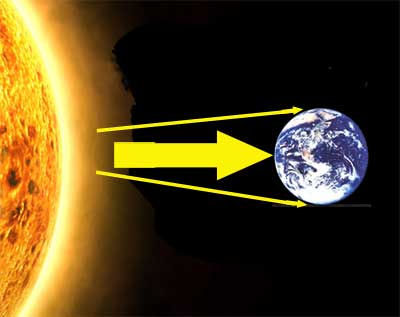
The rays of the Sun fall on the Earth The sun always stands directly on the equator and in the tropics, so the inhabitants of these places do not know the cold. There is not as sharp as ours, the seasons change, and it never snows. At the same time, part of the year, each of the two poles is turned towards the Sun, and the second part is hidden from it. When the Northern Hemisphere is turned towards the Sun, in countries north of the equator - summer and long days, to the south - winter and short days. When the direct rays of the Sun fall on the Southern Hemisphere, summer comes here, and winter in the Northern Hemisphere.
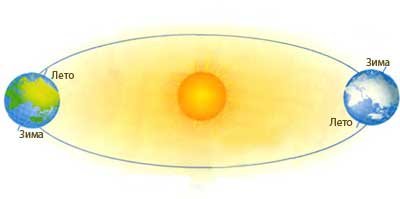
Winter and summer in the Northern and southern hemisphere The longest and shortest days of the year are called the winter and summer solstices. The summer solstice occurs on June 20, 21 or 22, and the winter solstice on December 21 or 22. And all over the world every year there are two days when the day is equal to the night. This happens in spring and autumn, exactly between the solstice days. In autumn, this happens around September 23 - this is the autumn equinox, in the spring around March 21 - the vernal equinox. Annual motion of the earth around the sun
